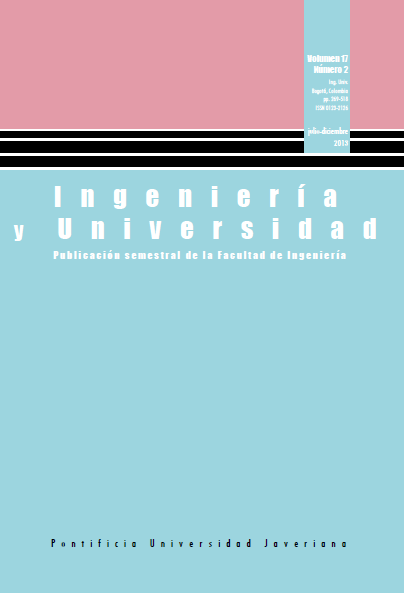Artificial neural networks to represent the attenuation of seismic intensity
##plugins.themes.bootstrap3.article.details##
The study of seismic intensity attenuation plays an important role in the analysis of menace that includes historical events. Mapping the intensity attenuation is usually done by regressing the intensity versus distance. Nowadays there are different ways to examine the characteristics of a seismic event using instrumental means, however, the experts face the problem of qualitative nature of the sources of information and the mapping of the relationship between intensity, magnitude and distance for the generation of risk scenarios based on historical information. This paper presents an alternative to map this relationship through artificial neural networks (ANN). As a result, we propose a procedure that was validated through the mapping of the intensities of 68 earthquakes that occurred northern South America, between 1766 and 2004. We found that ANNs present advantages with respect to the conventional models of regression: a. they preserve in a better way the first statistical moment, b. they reflect a minor approximation error and c. the variance explained by the ANN is better than the one from the models of statistical regression.
Seismic intensity, artificial neural networks, seismic attenuationIntensidad Sismica, Redes Neuronales, Atenuación Sismica
AMBRASEYS, N. y DOUGLAS, J. Magnitude Calibration of North Indian Earthquakes. Geophysical Journal International. 2004, vol. 159, núm. 1, pp. 165-206.
ARJUN, C. y KUMAR. A. Artificial Neural Network-Based Estimation of Peak Ground Acceleration. ISET Journal of Earthquake Technology. 2009, paper núm. 501, vol. 46, núm. 1, pp. 19-28.
BAKUN, W.; HAUGERUD, R.; HOPPER, M. y LUDWIN, R. The December 1872 Washington State Earthquake. Bulletin of the Seismological Society of America. 2002, vol. 92, núm. 8, pp. 3239-325.
BISHOP, C. Neural Networks for Pattern Recognition. Oxford: Oxford University Press, 1995.
BRICEÑO, L. A. Isosistas del sismo del Quindío (25/01/1999). 2004, Comunicación personal.
CHANG, L. y WHAN, H. Neural Network Based Models for Generating Artificial Earthquakes and Response Spectra. Computers & Structures. 2002, vol. 80, núm. 20-21, pp. 1627-1638.
CHÁVEZ, M. y CASTRO, R. Attenuation of Modified Mercalli Intensity with Distance in Mexico. Bulletin of the Seismological Society of America. 1988, vol. 78, núm. 6, pp. 1875-1884.
DERRAS, B. y BECKKOUCHE, A. Use of the Artificial Neural Networks for Peak Ground Acceleration Estimation. Lebanese Science Journal. 2011, vol.12, núm 2, pp. 101-115.
GASPERINI, P. The Attenuation of Seismic Intensity in Italy: A Bilinear Shape Indicates the Dominance of Deep Phases at Epicentral Distances Longer than 45 km. Bulletin of the Seismological Society of America. 2001, vol. 91, pp. 826-841.
GÓMEZ, A. y SALCEDO, E. Leyes de Atenuación de la Intensidad Macrosísmica en Colombia. Primer Simposio Colombiano de Sismología: Avances de la Sismología Colombiana en los últimos 20 Años. Ingeominas. Bogotá. Octubre 2002.
GÜNAYDIN, K. y GÜNAYDIN, A. Peak Ground Acceleration Prediction by Artificial Neural Networks for Northwestern Turkey. Mathematical Problems in Engineering. 2008, ID 919420, pp. 1- 20.
HAYKIN, S. Neural Network a Comprehensive Foundation. México: Prentice-Hall, 1994.
KIPLI, K.; MUHAMMAD, M.; MASNIAH, SH.; ZAMHARI, N.; LIAS, K. y AWANG, A. Performance of Levenberg - Marquardt Backpropagation for Full Reference Hybrid Image Quality Metrics. Processing of the International MultiConference of Engeneers and Computer Scientist. 2012, vol.1, pp. 1-4.
LEÓN, P. y GALVAN, I. Redes de Neuronas Artificiales, un Enfoque Práctico. Madrid: Pearson, Prentice Hall, 2003.
LOURAKIS, M. Brief Description of the Levenberg-Marquardt Algorithm Implemented by Levmar. Foundation of Research and Technology. 2005, vol. 4, pp. 1-6.
MASTERS, T. Practical Neural Network Recipes in C++. San Diego, CA.: Academic Press, 1993.
MUÑOZ, D. Conceptos Básicos en Riesgo Sísmico. Física de la tierra. 1989, núm. 1, pp.199-215.
MUSSON, R. Intensity Attenuation in the U.K. Journal of Seismology. 2005, vol. 9, pp. 73-86.
PASOLINI, C.; GASPERINI, P.; ALBARELLO, D.; LOLLI, D. y D’ARMICO, V. The Attenuation of Seismic Intensity in Italy, Part I: Theoretical and Empirical Background. Bulletin Seismological Society of America. 2008, vol. 98, núm. 2, pp. 682-691.
PENUMADU, D. y ZHAO, R. Triaxial Compression Behavior of Sand and Gravel Using ANN. International Journal of Computers and Geotechnics. 1999, vol. 24, núm. 3, pp. 207-230.
PRIETO, J.; FOSCHI. R.; VENTURA, C.; LIAM, W.; RAMOS, A. y PRADA-SARMIENTO, F. Atenuación y Distribución de Probabilidad de Intensidades Sísmicas para Colombia y el Occidente de Venezuela. Revista internacional de Desastres Naturales, Accidentes e Infraestructura Civil. 2011a. vol. 11, núm. 2, pp.183-196.
PRIETO, J.; FOSCHI. R.; VENTURA, C.; LIAM, W.; RAMOS, A. y PRADA-SARMIENTO, F. Probability Distribution of Intensity Attenuations for Colombia and Western Venezuela. Bulletin of the Seismological Society of America. 2011b. vol. 101, núm. 2, pp. 405-505.
PRIETO, J.; VENTURA, C.; LIAM, W.; RAMOS, A. y PRADA-SARMIENTO, F. Base de Datos de Intensidades Sísmicas para Colombia y el Occidente de Venezuela. Revista Internacional de Desastres Naturales, Accidentes e Infraestructura. 2011c. vol. 11, núm. 2, pp. 163-182.
SAUTER, F. Fundamentos de Ingeniería Sísmica: Introducción a la Sismología (I). Cartago, CR: Editorial Tecnológica de Costa Rica, 1989, 1a ed, 271p.
SIETSMA, J. y DOW, R. Creating Artificial Neural Networks that Generalize. Neural Network. 1991, vol. 4, núm. 1, pp. 67-79.
TABARES, H. y HERNÁNDEZ, J. Mapeo Curvas Típicas Demanda de Energía Eléctrica del Sector Residencial, Comercial e Industrial de la Ciudad de Medellín, Usando Redes Neuronales Artificiales y Algoritmos de Interpolación. Revista Facultad de Ingeniera Universidad de Antioquia. 2008, núm 46, pp. 110-118.
VILLACIS, C.; YAMADA, T y KANECO, F. Attenuation Relations for Ecuador, Appendix II, in the Quito, Ecuador, Earthquake Risk Management Project. Escuela Politécnica Nacional. Geohazards Interntaional Orstom-Quito and Oyo Corporation. 1994, pp. 162-181.


